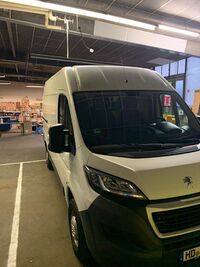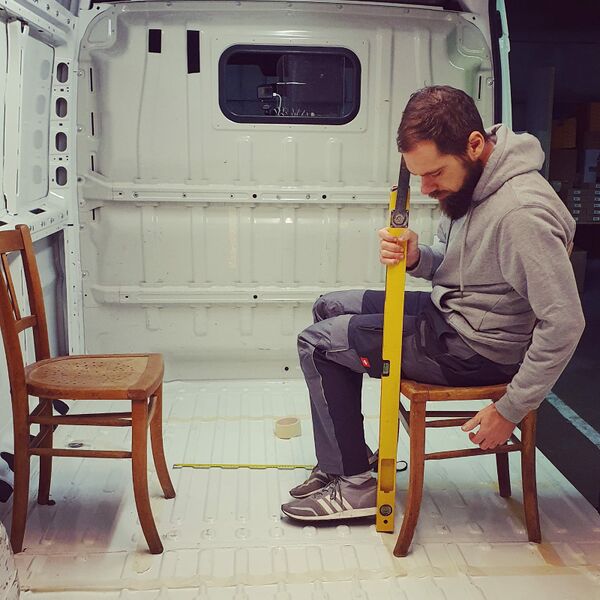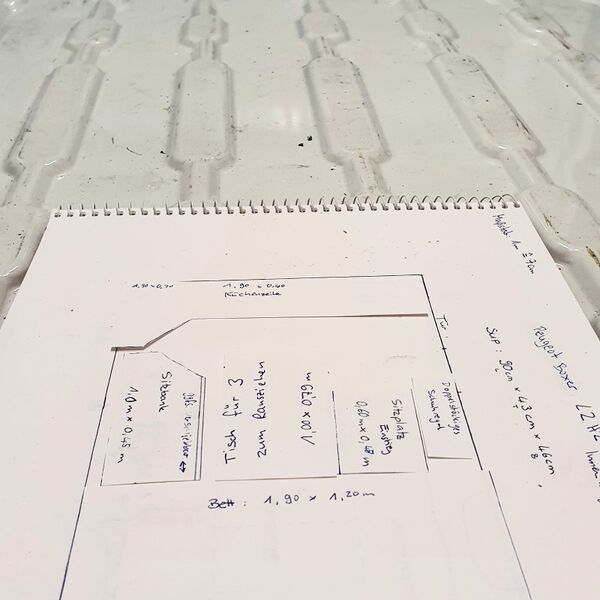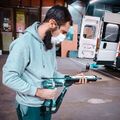Project:CamperVan: Difference between revisions
(how about this awesome photo instead of the "static" one to represent the project? Just a suggestion, feel free to undo :-)) |
|||
| (20 intermediate revisions by 2 users not shown) | |||
| Line 1: | Line 1: | ||
{{ProjectInfoBox|project title=Camper Van|status=In Progress|initiator=[[User:St3ffi|Steffi]] | This is the project page for a camper van called Lala Safari (lala = sleep, safari = travel). We tried to document the process. Make sure to check out our [https://www.instagram.com/lala.safari.van/ Instagram profile]. | ||
{{ProjectInfoBox | |||
|project title=Camper Van | |||
|status=In Progress | |||
|initiator=[[User:St3ffi|Steffi]] and [[User:Mfisch3r|Markus]] | |||
|date=September 2021 (started November 2020) | |||
|image=Seitenfenster ausschneiden.jpg | |||
|materials=[[Wood]] | |||
|software= | |||
}} | |||
== Motivation == | ==Motivation== | ||
We rented a camper van for one week and had a great road trip in switzerland. This was the start for us to think about owning a camper van. We like building and designing stuff and so we thought: let's go. | |||
== Planning a Camper Van == | ==Planning a Camper Van== | ||
Planning is a very important part of the process. You will buy a car, you will use it for some time and you have to live with all the decision you make. So take your time and think twice before building or buying the wrong stuff. | Planning is a very important part of the process. You will buy a car, you will use it for some time and you have to live with all the decision you make. So take your time and think twice before building or buying the wrong stuff. | ||
=== Vehicle Types === | ===Vehicle Types=== | ||
[[File:Camper Van.jpg|thumb|right|200px|our choice: Peugeot Boxer L2H2]] | |||
There are a lot of options but basically 3 types are relevant: | There are a lot of options but basically 3 types are relevant: | ||
# Small transporters like Defender 110 or Volkswagen TX (where x is a number between 1 and 7) or Volkswagen Caddy or Volkswagen Sharan or something similar by any other manufacturer. You cannot stand upright in those vehicles except you install something like a roof tent. | #Small transporters like Defender 110 or Volkswagen TX (where x is a number between 1 and 7) or Volkswagen Caddy or Volkswagen Sharan or something similar by any other manufacturer. You cannot stand upright in those vehicles except you install something like a roof tent. | ||
# Medium transporters like Mercedes Sprinter, Fiat Ducato, Peugeot Boxer, Citroen Jumper. You can buy those cars in different sizes. Typically the names are like L1H1 (Length 1 and Height 1) which is the smallest option with a loading space of 2,67m (length) x 1,87m (width) x 1,66m (height) (Fiat Ducato) and L5H3 which is the largest option with a loading space of 4,07m (length) x 1,87m (width) x 2,17m (height). So there may be vehicles in which you are easily able to stand upright. | # Medium transporters like Mercedes Sprinter, Fiat Ducato, Peugeot Boxer, Citroen Jumper. You can buy those cars in different sizes. Typically the names are like L1H1 (Length 1 and Height 1) which is the smallest option with a loading space of 2,67m (length) x 1,87m (width) x 1,66m (height) (Fiat Ducato) and L5H3 which is the largest option with a loading space of 4,07m (length) x 1,87m (width) x 2,17m (height). So there may be vehicles in which you are easily able to stand upright. | ||
# Large Transporters like Renault TRM 2000, Mercedes Unimog 404 or 1300L or any other really big vehicle. You will almost always need a special driver license in germany for those cars. | #Large Transporters like Renault TRM 2000, Mercedes Unimog 404 or 1300L or any other really big vehicle. You will almost always need a special driver license in germany for those cars. | ||
Once you make up your mind you will have to decide between a fairly new vehicle or an oldtimer. We bought Peugeot Boxer L2H2 from 2016 which was in a good condition and is not that big. We still want to drive on small streets leading to nice mountains. | Once you make up your mind you will have to decide between a fairly new vehicle or an oldtimer. We bought Peugeot Boxer L2H2 from 2016 which was in a good condition and is not that big. We still want to drive on small streets leading to nice mountains. | ||
<br clear=right> | |||
=== The Layout === | ===The Layout=== | ||
The layout is very essential for your build. Our build has a fixed bed. A very good video with all pros and cons for fixed bed vs dinette: https://www.youtube.com/watch?v=Zz1fBVYK_2c&ab_channel=VanlifeSagas | The layout is very essential for your build. Our build has a fixed bed. A very good video with all pros and cons for fixed bed vs dinette: https://www.youtube.com/watch?v=Zz1fBVYK_2c&ab_channel=VanlifeSagas | ||
=== Finding and Buying a Vehicle === | ===Finding and Buying a Vehicle=== | ||
Often you can find a van like a Peugeot Boxer from electricians or other craftsman. Typically you need to search in the news paper, mobile.de, autoscout24.de etc. | Often you can find a van like a Peugeot Boxer from electricians or other craftsman. Typically you need to search in the news paper, mobile.de, autoscout24.de etc. | ||
| Line 25: | Line 36: | ||
We bought our van from a official Peugeot dealer. We even got a one year guarantee in Europe. | We bought our van from a official Peugeot dealer. We even got a one year guarantee in Europe. | ||
=== Insurance and Registration === | ===Insurance and Registration=== | ||
=== Plan your Build === | ===Plan your Build=== | ||
[[File:Layout Testing.jpg|thumb|600x600px|Layout testing in the van is the second step. Simply use masking tape]] | [[File:Layout Testing.jpg|thumb|600x600px|Layout testing in the van is the second step. Simply use masking tape]] | ||
[[File:Layout on Paper.jpg|center|thumb|600x600px|Testing the layout on paper is very easy and effective]] | [[File:Layout on Paper.jpg|center|thumb|600x600px|Testing the layout on paper is very easy and effective]] | ||
=== Tools you will need === | ===Tools you will need=== | ||
Probably at least: | Probably at least: | ||
* [[Plunge Saw]] | *[[Plunge Saw]] | ||
* [[Drills]] | *[[Drills]] | ||
* [[Chop Saw]] | *[[Chop Saw]] | ||
* [[Table Saw]] | *[[Table Saw]] | ||
* [[Belt Sander]] | *[[Belt Sander]] | ||
* [[Handheld Router]] | *[[Handheld Router]] | ||
* [[Router Table]] | *[[Router Table]] | ||
===Stuff you have to buy === | |||
*lots of screws (stainless steel is recommended) | |||
*glue like dekasyl ms-5 (polymer power glue, uv resistant, seals and glues) | |||
* wood | |||
*etc. | |||
# | # | ||
==Building the Camper Van== | ==Building the Camper Van== | ||
=== Clean-up and Rust Prevention === | ===Clean-up and Rust Prevention=== | ||
First of all we cleaned the van. We were very lucky. The vendor offered was still interested in the existing interior (brackets, floor plate, rails...). So he offered to buy the stuff. Hence the van was already empty. So our steps were: | |||
#cleaning with water and dish detergent | |||
#locating rust | |||
#removing the rust with the grinder | |||
#applying metal protection (Hammerite) | |||
We had only a few rusty spots. So the work was done within 1 or 2 days. | |||
===Setting up the Floor=== | |||
One of our highest priorities for the van is the usable height inside. We want at least 1.88m of height in the van. So we needed to build our floor construction as low as possible. The floor of the van is not flat. The lower section are 20mm (estimated) lower than the higher sections. Between the alternating sections there is a space of 50mm (estimated). There perfect fit were wood (spruce) laths 18x45mm. | |||
We glued the laths to the floor of the car with dekasyl ms-5 which is a polymer power glue. It will probably hold as good as with screws and we will not have any holes in the car which may cause rust. Since the glue sits between the metal floor and the laths (about 2mm of glue) this is also a good way to protect the wood from the cold metal. | |||
Our floor is then a 9mm sheet of coated plywood. | |||
=== Insulation === | <gallery> | ||
File:Floor1.jpg|Adding glue to the lathes | |||
File:Floor2.jpg|Adding glue to the lathes / 2 | |||
File:Glue-gun.jpg|Caulking gun which you can use with your drill. Very good tool for such a task! | |||
File:Floor-cutting-1.jpg|The foil is a our template for the van floor. | |||
File:Bodenplatte1.jpg|First promising results | |||
File:Bodenplatte2.jpg|Finished! We marked the position of out lathes with tape | |||
</gallery>We needed 9 cartridges of dekasyl. We really recommend to use a good caulking gun for this task. As you can see in the pictures we first used the very simple one. We then upgraded then to a caulking gun which works with drills. We were at least 4 times faster with this method and our hands were fine... | |||
===Insulation=== | |||
This is a very special topic. There are very different opinion how a camper van should be isolated: | This is a very special topic. There are very different opinion how a camper van should be isolated: | ||
* not at all | * not at all | ||
* wool or other natural material | *wool or other natural material | ||
* styrodur and a moisture barrier | *styrodur and a moisture barrier | ||
* armaflex | *armaflex | ||
| Line 66: | Line 104: | ||
There are different sizes available. We used 19mm for the floor, ceiling and most of the walls. We also used 9mm for those parts which we will cover with wood. | There are different sizes available. We used 19mm for the floor, ceiling and most of the walls. We also used 9mm for those parts which we will cover with wood. | ||
You can cut armaflex very easy with a sharp box cutter. <gallery | You can cut armaflex very easy with a sharp box cutter. <gallery> | ||
File:Floor-insulation3.jpg|We cutted lanes of armaflex for our floor. Make sure you clean the surface (with alcohol or something else) before you stick the armaflex to it. | File:Floor-insulation3.jpg|We cutted lanes of armaflex for our floor. Make sure you clean the surface (with alcohol or something else) before you stick the armaflex to it. | ||
File:Floor-insulation2.jpg|Progress... | File:Floor-insulation2.jpg|Progress... | ||
File:Floor insulation.jpg|Floor already done. This took us about 2.5 hours | File:Floor insulation.jpg|Floor already done. This took us about 2.5 hours | ||
| Line 74: | Line 112: | ||
</gallery> | </gallery> | ||
=== Windows === | ===Windows=== | ||
The van has two rear windows, one in each of door. Additionally we wanted two roof windows and one side window. | |||
====Roof Windows with and without Fan==== | |||
The first roof window is placed over the bed, which is located in the back of the van. The second one is placed over the kitchen, which is located near the dividing wall in the front of the van. | |||
This window over the bed is a [https://www.dometic.com/de-de/de/produkte/klima/fenster-und-tueren/wohnmobil-dachfenster/dometic-mini-heki-style-_-24856 simple window] with an opening of 40x40cm. The one over the kitchen is a [https://www.airxcel.com/rv/maxxair/products/fans/maxxfan-deluxe window with an electrical fan] with an integrated rain cover. So we can use the fan also when it is raining. It can blow air inside the vehicle or suck the air out of the vehicle. We plan to use it as a hood for our cooking fumes. | |||
==== | <gallery perrow="8" mode="slideshow"> | ||
File:Rahmenbau.jpg|We needed to build a wood frame for the windows | |||
File:Window-cutting.jpg|Cutting a hole in the roof of the van for the window. Make sure to use saw blades for metal. | |||
File:Window drilling holes.jpg|Drilling the holes for the window. We can later screw the window through the roof the van to our wood frame. | |||
File:Rostschutz loecher.jpg|We had to drill some hills to mount the window. So we also added rust protection. | |||
File:Rahmen kleben.jpg|We glued the wood frame to the ceiling of the van | |||
File:Rahmen kleben2.jpg|We glued the wood frame to the ceiling of the van / 2 | |||
File:Ausgleich sicken.jpg|The roof of the van is also not flat (like the floor), so we used acryl glass and glue as a leveling compound. | |||
File:Ausgleich sicken 2.jpg|Mounting the acryl glass to the van | |||
File:Fenster kleben.jpg|adding glue to the window | |||
File:Glue-on-window.jpg|glue added to the window | |||
File:Fenster einsetzen.jpg|mouting the window in the hole | |||
File:Fenster verbaut.jpg|the mounted window | |||
File:Fenster verbaut dach.jpg|both windows are mounted | |||
</gallery> | |||
====Side Window==== | |||
For the side window we cut a hole of 90x45cm in the sliding door of the van. The window (CARBEST elegance 900 x 450 mm) also needed a wooden frame like the windows for the roof. We added the window since we wanted to have more light in the van. <gallery> | |||
File:Seitenfenster Holzrahmen.jpg|The wooden frame for the side window | |||
File:Seitenfenster ausschneiden.jpg|cutting the hole for the side window in the sliding door | |||
File:Seitenfenster kleber entfernen.jpg|cleaning up the black glue from the sliding door. Make sure to use tape, then it is much easier to clean up the excessive glue. | |||
</gallery> | |||
=== Electrics === | ===Electrics=== | ||
==== Calculating Cables ==== | ====Calculating Cables==== | ||
==== Lighting ==== | ====Lighting==== | ||
==== Solar System ==== | ====Solar System==== | ||
==== Inverter ==== | ====Inverter==== | ||
=== Ceiling === | ===Ceiling=== | ||
Latest revision as of 02:03, 4 September 2022
This is the project page for a camper van called Lala Safari (lala = sleep, safari = travel). We tried to document the process. Make sure to check out our Instagram profile.
| ProjectInfoBox Camper Van | |
|---|---|
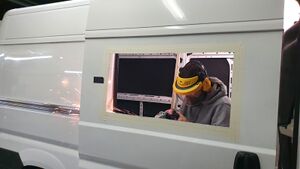
| |
| Status: | In Progress |
| Release Date: | September 2021 (started November 2020) |
| Initiator: | Steffi and Markus |
| Materials Used: | Wood |
Motivation
We rented a camper van for one week and had a great road trip in switzerland. This was the start for us to think about owning a camper van. We like building and designing stuff and so we thought: let's go.
Planning a Camper Van
Planning is a very important part of the process. You will buy a car, you will use it for some time and you have to live with all the decision you make. So take your time and think twice before building or buying the wrong stuff.
Vehicle Types
There are a lot of options but basically 3 types are relevant:
- Small transporters like Defender 110 or Volkswagen TX (where x is a number between 1 and 7) or Volkswagen Caddy or Volkswagen Sharan or something similar by any other manufacturer. You cannot stand upright in those vehicles except you install something like a roof tent.
- Medium transporters like Mercedes Sprinter, Fiat Ducato, Peugeot Boxer, Citroen Jumper. You can buy those cars in different sizes. Typically the names are like L1H1 (Length 1 and Height 1) which is the smallest option with a loading space of 2,67m (length) x 1,87m (width) x 1,66m (height) (Fiat Ducato) and L5H3 which is the largest option with a loading space of 4,07m (length) x 1,87m (width) x 2,17m (height). So there may be vehicles in which you are easily able to stand upright.
- Large Transporters like Renault TRM 2000, Mercedes Unimog 404 or 1300L or any other really big vehicle. You will almost always need a special driver license in germany for those cars.
Once you make up your mind you will have to decide between a fairly new vehicle or an oldtimer. We bought Peugeot Boxer L2H2 from 2016 which was in a good condition and is not that big. We still want to drive on small streets leading to nice mountains.
The Layout
The layout is very essential for your build. Our build has a fixed bed. A very good video with all pros and cons for fixed bed vs dinette: https://www.youtube.com/watch?v=Zz1fBVYK_2c&ab_channel=VanlifeSagas
Finding and Buying a Vehicle
Often you can find a van like a Peugeot Boxer from electricians or other craftsman. Typically you need to search in the news paper, mobile.de, autoscout24.de etc.
Beware: Try to buy your used car from a official dealer or from a private person. Used-car dealers often do not have any clue about the car and its condition. Sometimes they will even deny you the implied warranty. They just wanna earn quick money.
We bought our van from a official Peugeot dealer. We even got a one year guarantee in Europe.
Insurance and Registration
Plan your Build
Tools you will need
Probably at least:
Stuff you have to buy
- lots of screws (stainless steel is recommended)
- glue like dekasyl ms-5 (polymer power glue, uv resistant, seals and glues)
- wood
- etc.
Building the Camper Van
Clean-up and Rust Prevention
First of all we cleaned the van. We were very lucky. The vendor offered was still interested in the existing interior (brackets, floor plate, rails...). So he offered to buy the stuff. Hence the van was already empty. So our steps were:
- cleaning with water and dish detergent
- locating rust
- removing the rust with the grinder
- applying metal protection (Hammerite)
We had only a few rusty spots. So the work was done within 1 or 2 days.
Setting up the Floor
One of our highest priorities for the van is the usable height inside. We want at least 1.88m of height in the van. So we needed to build our floor construction as low as possible. The floor of the van is not flat. The lower section are 20mm (estimated) lower than the higher sections. Between the alternating sections there is a space of 50mm (estimated). There perfect fit were wood (spruce) laths 18x45mm.
We glued the laths to the floor of the car with dekasyl ms-5 which is a polymer power glue. It will probably hold as good as with screws and we will not have any holes in the car which may cause rust. Since the glue sits between the metal floor and the laths (about 2mm of glue) this is also a good way to protect the wood from the cold metal.
Our floor is then a 9mm sheet of coated plywood.
We needed 9 cartridges of dekasyl. We really recommend to use a good caulking gun for this task. As you can see in the pictures we first used the very simple one. We then upgraded then to a caulking gun which works with drills. We were at least 4 times faster with this method and our hands were fine...
Insulation
This is a very special topic. There are very different opinion how a camper van should be isolated:
- not at all
- wool or other natural material
- styrodur and a moisture barrier
- armaflex
The option to use no insulation at all was never an option for us. We want to use the van also in cold climates (Norway in september/october....) and we believe that some kind of insulation will at least help use to keep the existing warmth inside. But you need to be aware that it is not easy to insulate a van. There are a lot of holes which you cannot reach and it is also quite common for this kind of vehicle, that there are holes which will lead condensed water out of the vehicle.
We used armaflex since it is easy to handle (you can buy it with in a self-adhesive version), pretty much hydrophobic and hardly inflammable. There are different types of armaflex. We used armaflex xg which has almost the same quality attributes as the superior, and very expensive, armaflex af. Do not use armaflex ace since it is kind of an old version of the material.
There are different sizes available. We used 19mm for the floor, ceiling and most of the walls. We also used 9mm for those parts which we will cover with wood.
You can cut armaflex very easy with a sharp box cutter.
Windows
The van has two rear windows, one in each of door. Additionally we wanted two roof windows and one side window.
Roof Windows with and without Fan
The first roof window is placed over the bed, which is located in the back of the van. The second one is placed over the kitchen, which is located near the dividing wall in the front of the van.
This window over the bed is a simple window with an opening of 40x40cm. The one over the kitchen is a window with an electrical fan with an integrated rain cover. So we can use the fan also when it is raining. It can blow air inside the vehicle or suck the air out of the vehicle. We plan to use it as a hood for our cooking fumes.
Side Window
For the side window we cut a hole of 90x45cm in the sliding door of the van. The window (CARBEST elegance 900 x 450 mm) also needed a wooden frame like the windows for the roof. We added the window since we wanted to have more light in the van.
